Abstract
Introduction:
Pain of endodontic origin has been a major concern to the patients and the clinicians for many years. Post-operative pain is associated with inflammation in the periradicular tissues caused by irritants egressing from root canal during treatment. It has been suggested that calcium hydroxide intra-canal medicament has pain-preventive properties because of its anti-microbial or tissue altering effects. Some dispute this and reasoned that calcium hydroxide may initiate or increase pain by inducing or increasing inflammation.
Objective:
To evaluate the effectiveness of calcium hydroxide in reducing the post-treatment pain when used as an intra-canal medicament
Materials and Methods:
The following databases were searched: PubMed CENTRAL (until July 2013), MEDLINE, and Cochrane Database of Systematic Reviews. Bibliographies of clinical studies and reviews identified in the electronic search were analyzed for studies published outside the electronically searched journals. The primary outcome measure was to evaluate the post-treatment pain reduction when calcium hydroxide is used as an intra-canal medicament in patients undergoing root canal therapy.
Results:
The reviews found some clinical evidence that calcium hydroxide is not very effective in reducing post-treatment pain when it is used alone, but its effectiveness can be increased when used in combination with other medicaments like chlorhexidine and camphorated monochlorophenol (CMCP).
Conclusion:
Even though calcium hydroxide is one of the most widely used intra-canal medicament due to its anti-microbial properties, there is no clear evidence of its effect on the post-treatment pain after the chemo-mechanical root canal preparation.
Keywords: Calcium hydroxide, inter appointment pain, intra-canal medicament, post-treatment pain, root canal medicament, root canal therapy
INTRODUCTION
Pain is the most common cause for physician consultation. It is the main symptom in many medical and dental conditions and can significantly alter the person's quality of life and general functioning.[1] Pain of endodontic origin has been a common concern for both the clinicians and the patients for many years. Endodontic post-treatment pain remains to be significant problem facing the dental profession.[2] Endodontic pain may occur before, during, or after endodontic treatment.[1]
Pain may occur as a result of various causes such as microbial factors, change in the periapical tissue pressure, chemical mediators, change in the cyclic mediators, and various physiologic factors.[2] The pain may be dependent on the damage sustained by tissues and the nature of the damaging agent. These agents may be of a bacterial, chemical, or mechanical nature.[1] The development of post-treatment pain of mild intensity is not a rare event, even when endodontic treatment has followed acceptable standards. Torabinajad et al. (1988) reported the occurrence of inter-appointment discomforts in approximately 50% of 2000 patients who underwent root canal therapy in pulpless teeth.[3]
The presence of micro-organisms as a result of failure to properly disinfect the canal is the most common cause of pain.[2] Thus, endodontic therapy is primarily focused on maximum elimination of these bacteria. Antibacterial intra-canal dressing has been advocated to eliminate remaining bacteria after chemo-mechanical preparation.
Calcium hydroxide intra-canal dressing is considered as the most favorable anti-microbial agent.[4] Several well controlled in-vitro and in-vivo studies have shown intra-canal reduction of microbial population or at least inhibit bacterial proliferation. Calcium hydroxide also alters bacterial cell wall and denatures a potent endotoxin, lipopolysaccharide, thereby rendering it less antigenic.[5]
Of clinical interest, and certainly related to the biological response to calcium hydroxide as intra-canal medication, is its relationship to post-treatment pain after an appointment. It has been suggested that calcium hydroxide has pain-preventive properties because of its anti-microbial or tissue-altering effects.[5]
AIM
The aim of this systematic review was to evaluate the effectiveness of calcium hydroxide in reducing the inter-appointment pain when used as an intra-canal medicament.
STRUCTURED QUESTIONS
Is calcium hydroxide intra-canal medicament effective in reducing post-treatment pain in patients undergoing root canal therapy?
PICO ANALYSIS
Population-Patients undergoing root canal therapy.
Intervention-Calcium hydroxide.
Outcome-Post-treatment pain
NULL HYPOTHESIS
There is no difference in the post-treatment pain with or without calcium hydroxide intra-canal medicament.
MATERIALS AND METHODS
Sources used
For identification of studies included or considered for this review, detailed search strategies were carried out on the following databases.
PubMed (until July 2013)
PubMed Advanced Search (until July 2013)
MEDLINE
Cochrane Database of Systematic Reviews
No limits and language restriction were applied during the electronic search to include all the possible clinical trials in the potential relevant article search phase of the systematic review. No time restriction was applied. Reference list of the reviews and of the identified randomized trials were also checked for possible additional studies.
Language
There were no language restrictions.
Hand searching
The following journals were hand searched:
Journal of Endodontics
International Endodontic Journal
Oral Surgery Oral Medicine Oral Pathology Oral Radiology Endodontology
INCLUSION CRITERIA
Criteria for considering studies for this review
Types of studies
Randomized controlled trials.
Studies comparing post-operative pain using calcium hydroxide intra-canal medicament with others.
Types of participants
All the patients who are undergoing root canal therapy.
EXCLUSION CRITERIA
The following studies were excluded,
Case reports/case series
Animal studies
In vitro studies
Studies not meeting the inclusion criteria
Studies in which calcium hydroxide intra-canal medicament is not used or if used in combination.
RESULTS
Description of studies
The search identified 170 publications, out of which 153 were excluded after reviewing the title or abstract. Full articles were obtained for 17 studies; 11 of these publications were excluded after reading the full text article (details of the excluded articles are given in Table 1). So, a total of 6 articles fulfilled the inclusion criteria. Three hand-searched articles which fulfilled the inclusion. Therefore, a total of 9 publications fulfilled all criteria for inclusion. (Table 2 shows the Variable of interest for this systematic review and general information of the selected articles are given in Table 3). Graph 1 shows the number of studies conducted in different time period and Graph 2 shows the sample size included in each article. Chart 1 shows the search flowchart.
Table 1.
Characteristics of excluded studies

Table 2.
Variables of interest
![]()
Table 3.
General information of selected articles
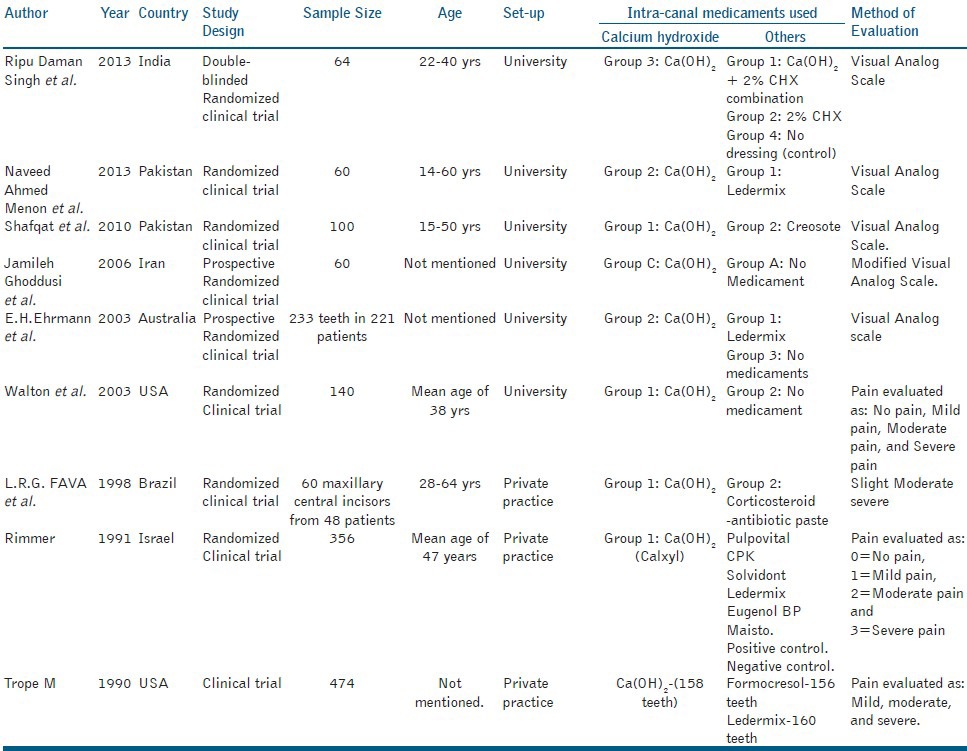
Graph 1.

No of studies
Graph 2.
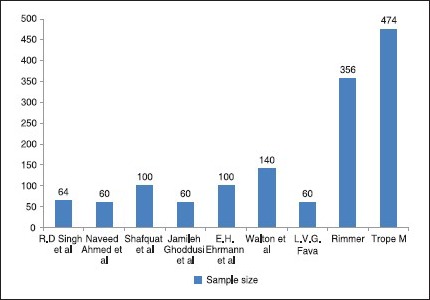
Sample size
Chart 1.
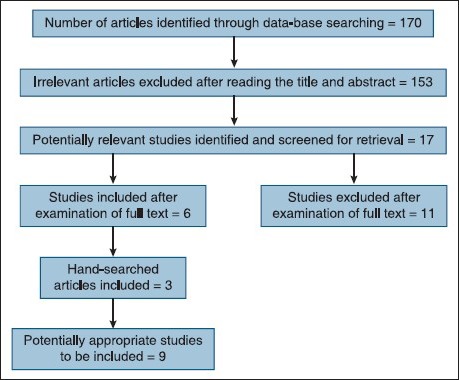
Search flow chart
Quality assessment
The quality assessment of included trials was undertaken independently as a part of data extraction process. Four main quality criteria were examined:
-
Method of Randomization, recorded as
- Yes – Adequate as described in the text
- No – Inadequate as described in the text
- Unclear in the text
-
Allocation Concealment, recorded as
- Yes – Adequate as described in the text
- No – Inadequate as described in the text
- Unclear in the text
-
Outcomes assessors blinded to intervention, recorded as
- Yes – Adequate as described in the text
- No – Inadequate as described in the text
- Unclear in the text
-
Completeness of follow-up (was there a clear explanation for withdrawals and dropouts in each treatment group) assessed as:
- Yes – Dropouts were explained
- No – Dropouts were not explained
- None – No Dropouts or withdrawals
Other methodological criteria examined included:
Presence or absence of sample size calculation
Comparability of groups at the start
Clear inclusion/exclusion criteria
Presence/absence of estimate of measurement error. The validity and reproducibility of the method of assessment.
Risk of bias in included studies
The assessments for the four main methodological quality items are shown in table. The study was assessed to have a “High risk” of bias if it did not record a “regeneration” in three or more of the four main categories, “regeneration” if two out of four categories did not record a “Yes,” and “regeneration” if randomization assessor blinding and completeness of follow – up were considered adequate.
DISCUSSION
Interpretation of results
According to Ripu Singh et al.,[2] the study was performed on 64 patients. After chemo-mechanical procedures, the teeth were randomized into four groups (n = 16). In Gr-I: Calcium hydroxide paste mixed with 2% chlorhexidine gel, Gr-II: 2% chlorhexidine gel, Gr-III: Calcium hydroxide paste, and Gr-IV received no dressing (control) [Table 3]. Pain experienced by the patients was then evaluated at 4 h after treatment and daily for a further 24, 48, 72, and 96 for the post-treatment pain. And, they have concluded that chlorhexidine alone and calcium hydroxide plus chlorhexidine gave rise to less pain than that experienced by patients who had a calcium hydroxide dressing alone or no dressing at all [Tables 4 and 5].
Table 4.
Results
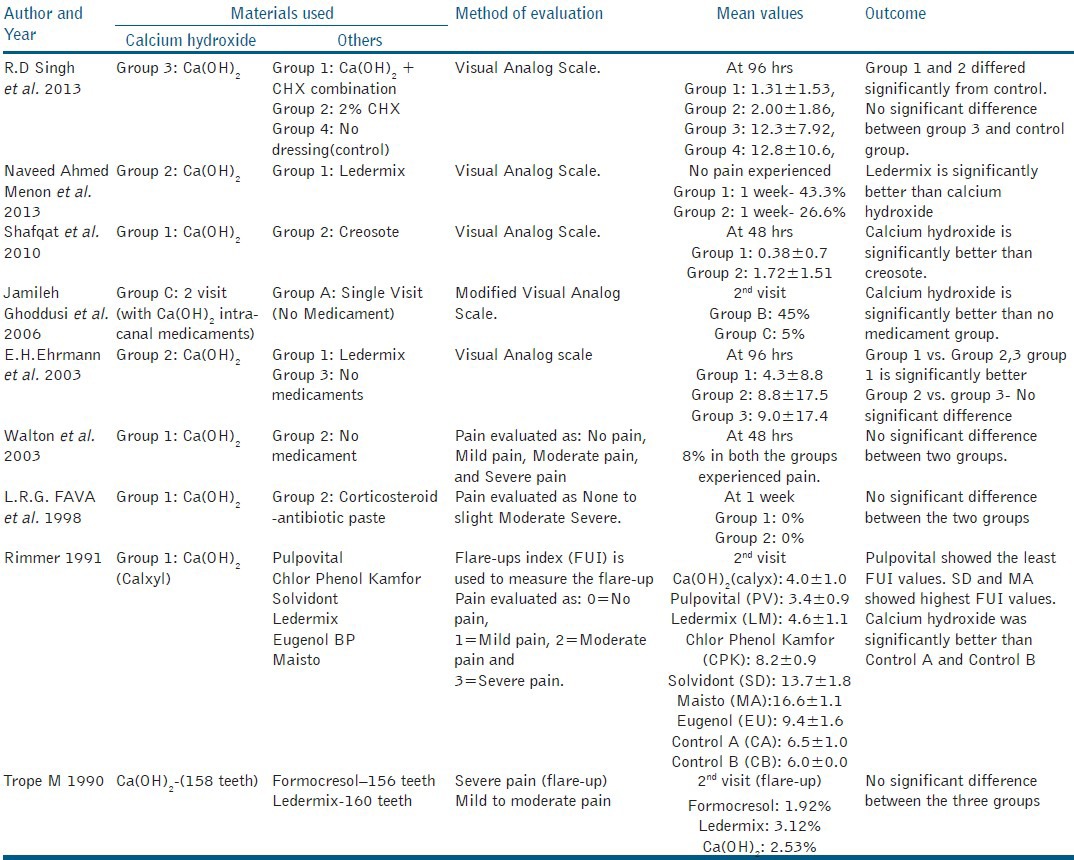
Table 5.
Summation tables for individual parameters
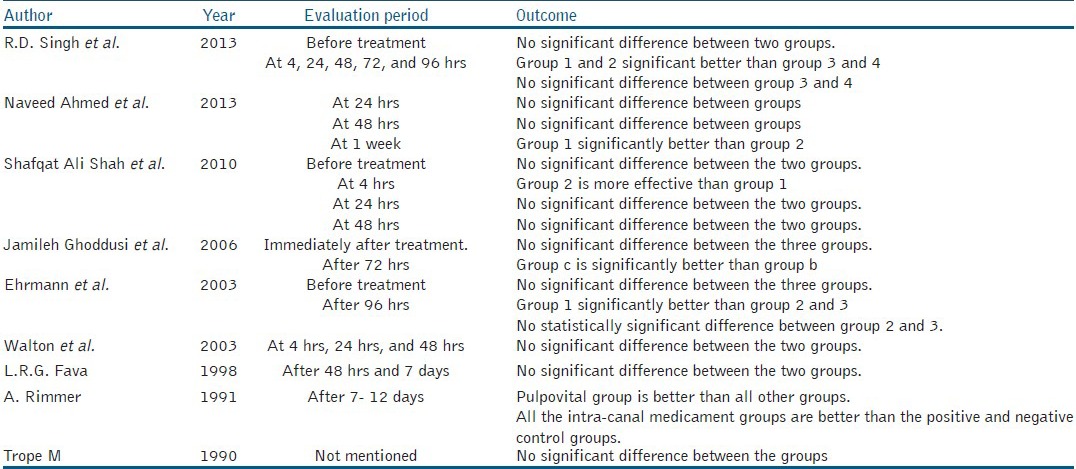
According to Naveed Ahmed et al.,[1] 60 patients were included in this study. Patients were equally divided into two groups (n = 30). Thirty patients were in Gr-I: Ledermix paste and Gr-II: Calcium hydroxide [Table 3]. Comparison of inter-appointment pain between groups after post-operative next day was not significant (P = 0.59). Similarly, at third day, mild pain was observed in 3.3% (2/60), but there was no significant difference between groups. While after one week, mild pain was found in only 1.6% (1/60) cases. Severity of pain was significantly low in group I than in group II after one week [Tables 4 and 5].
According to Shafqat Ali Shah et al.,[6] 100 patients were equally divided into two groups (n = 50). Gr-1: Calcium hydroxide and Gr-2: Creosote [Table 3]. Creosote was significantly better than calcium hydroxide at the 4 hours evaluation period. But, at the 48 hours evaluation period, calcium hydroxide proved to be better than creosote [Tables 4 and 5].
According to Jamileh Ghoddus et al.,[4] 60 patients were randomly divided into three equal groups. Gr-A: Single visit, Gr-B: Two-visit without intra-canal medicament, Gr-C: Two-visit with calcium hydroxide intra-canal medicament [Table 3]. This study concluded that calcium hydroxide is significantly better than the no medicament group in two-visit root canal therapy [Tables 4 and 5].
According to Ehrmann et al.,[7] 100 teeth were randomly divided into three groups. Gr-1: Ledermix, Gr-2: Calcium hydroxide, and Gr-3: No dressing. Gr-1 was significantly better than Gr-2 and 3 [Table 3], and no significant difference is seen between Gr-2 and 3 [Tables 4 and 5].
According to Walton et al.,[5] 140 patients receiving root canal treatment were randomly divided into two equal groups (n = 70). Gr-1: Calcium hydroxide and Gr-2: No dressing [Table 3]. This study concluded that there was no significant difference between the two groups [Tables 4 and 5].
According to L.V.G. Fava,[8] 60 teeth from 48 patients were randomly distributed between two groups (n = 30). Gr-1: Calcium hydroxide and Gr-2: Corticosteroid antibiotic solution [Table 3]. The results of this clinical evaluation showed no significant difference in the incidence of pain between two groups [Tables 4 and 5].
According to A. Rimmer (1991),[9] a group of 356 individuals requiring root canal therapy were included and distributed into seven groups [Table 3]. The results of this study concluded that Pulpovital and Ledermix were significantly better than all other medicaments and calcium hydroxide was better than the two control groups [Tables 4 and 5].
According to Trope,[10] a total of 474 patients participated in the study were distributed into three medicament groups containing, formocresol (n = 156), Ledermix (n = 160) and calcium hydroxide [Table 3]. Finally, author concluded that there was no significant difference between three groups [Tables 4 and 5].
DEFENDING THE RESULTS
Out of the nine clinical trials included in this systematic review, five studies compared calcium hydroxide with that of the no dressing group (control group).[2,4,5,9] Out of these five studies, three studies have concluded that there is no difference between the root canals, which had not received any medicament (control) and the calcium hydroxide groups. Only two studies concluded that calcium hydroxide is better than the no medicament group [Table 6]. This limited action of calcium hydroxide could be because of the buffering effect that dentin exerts over calcium hydroxide, reducing its anti-microbial action.[2] In addition, few studies[13,14] found that certain bacteria found in the root canal system were resistant to high pH of calcium hydroxide.
Table 6.
Studies comparing calcium hydroxide vs. no medicament

One study[2] compared chlorhexidine, chlorhexidine plus calcium hydroxide combination, and calcium hydroxide alone, and they have concluded that chlorhexidine and the combination of chlorhexidine plus calcium hydroxide is significantly better than calcium hydroxide alone [Tables 7 and 8]. Studies found that chlorhexidine gel provided 100% inhibition of micro-organisms at a depth of 200 μm as well as 400 μm from day 1 and thus demonstrating its high diffusibility.[15,16] Moreover, the effectiveness of chlorhexidine as intra-canal medication in controlling the post-operative pain might be because of its ability to reduce or eliminate the endotoxins associated with the development of spontaneous pain.[2] Gama et al.,[12] who reported that intra-canal dressings with 0.2% chlorhexidine gluconate or calcium hydroxide in combination with CPCM were equally effective in reducing the post-operative pain.
Table 7.
Studies comparing calcium hydroxide vs 2% chlorhexidine

Table 8.
Studies comparing calcium hydroxide vs. Calcium hydroxide and 2% chlorhexidine combination

Five studies compared calcium hydroxide and other medicaments containing corticosteroids.[2,8,9,11] Out of these five studies, four studies have concluded that medicaments with the corticosteroid component in them are significantly better than calcium hydroxide in reducing the post-treatment pain [Table 9]. This can be attributed to the anti-inflammatory action of corticosteroids. Ledermix is one among these medicaments. In four studies, Ledermix was compared with calcium hydroxide,[1,7,9,10] and three studies concluded that Ledermix is better than calcium hydroxide in reducing post-treatment pain [Table 10].
Table 9.
Studies comparing calcium hydroxide vs. Medicaments containing corticosteroids.

Table 10.
Studies comparing calcium hydroxide vs. Ledermix

One study has compared calcium hydroxide with creosote[6] and concluded that calcium hydroxide is better in reducing the post-treatment pain. Creosote is an antiseptic phenolic intra-canal medicament that by nature is toxic to mammalian cells and can cause periapical irritation. The antibacterial action of the antiseptics-containing medicaments is limited and of short. Therefore, their efficacy as root canal medicaments is questionable. Due to the extreme toxicity of these chemicals, they could not be placed in direct contact with living tissue. The antiseptic was either applied on a cotton pellet, which was placed in the pulp chamber, or on an absorbent paper cone placed in the root canal [Table 11]. And, one study compared formocresol and calcium hydroxide and found no significant difference [Table 12].
Table 11.
Studies comparing calcium hydroxide vs. Creosote

Table 12.
Studies comparing calcium hydroxide vs. Formocresol

Quality of evidence
Eight of the studies included in this review have a level of evidence 2. One trial done by Trope M (1990) the level of evidence was 3. All are randomized clinical trials, except one trial done by Trope M (1990) [Table 13], thus the level of evidence is high. Eight out of nine trials included in this systematic review showed a “regeneration” risk of bias, whereas one study showed a “regeneration” risk of bias [Tables 14 and 15]. Hence, the interpretations obtained from these studies are proposed to be reliable but not conclusive.
Table 13.
Evidence of selected articles
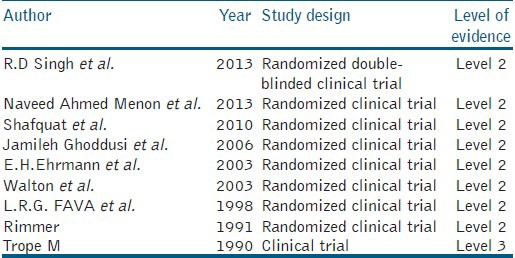
Table 14.
Risk of bias-major criteria

Table 15.
Risk of bias-minor criteria
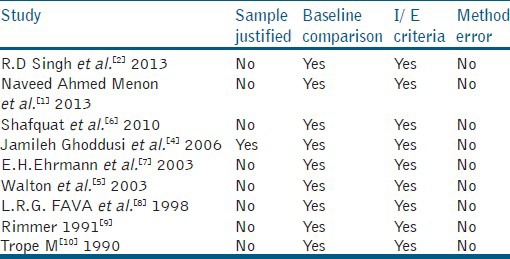
Implications for practice
Even though calcium hydroxide is one of the most widely used intra-canal medicament due to its anti-microbial properties, there is no clear evidence of its effect on the post-treatment pain after the chemo-mechanical root canal preparation.
Implications for research
More high quality clinical trials are required to prove the effectiveness of calcium hydroxide in reducing the post-treatment pain.
Report of outlier data
No outlier data obtained.
SUMMARY
The aim of this systematic review was to evaluate the effectiveness of calcium hydroxide in reducing the post-treatment pain when used as an intra-canal medicament. For identification of studies included or considered for this review, detailed search strategies were carried out on the following databases: PubMed (until July 2013), PubMed Advanced Search (until July 2013), MEDLINE, and Cochrane Database of Systematic Reviews
The search identified 170 publications, out of which 153 were excluded after reviewing the title or abstract. Full articles were obtained for 17 studies; 11 of these publications were excluded after reading the full text article. So, a total of six studies were included. Three hand searched publications, which fulfilled the inclusion criteria. Therefore, a total of nine publications fulfilled all criteria for inclusion [Chart 1].
CONCLUSION
From this systematic review, it can be concluded that the use of calcium hydroxide as an intra-canal medicament was unrelated to the incidence and severity of post-treatment pain. Calcium hydroxide is not very effective in reducing post-treatment pain when it is used alone,[2,5,7] but its effectiveness can be increased when used in combination with other medicaments like chlorhexidine and camphorated monochlorophenol (CMCP).[2,11]
Footnotes
Source of Support: Nil
Conflict of Interest: None declared
REFERENCES
- 1.Memon NA, Memon MR, Ali F, Noor-UL-ANE Assessment of the Interappointment pain by using two different intracanal medicaments. Pak Oral Dent J. 2013;33:145–50. [Google Scholar]
- 2.Singh RD, Khatter R, Bal RK, Bal CS. Intracanal medications versus placebo in reducing postoperative endodontic pain-a double-blind randomized clinical trial. Braz Dent J. 2013;24:25–9. doi: 10.1590/0103-6440201302039. [DOI] [PubMed] [Google Scholar]
- 3.Torabinejed M, Kettering JD, Mc Graw JC, Cummings RR, Dwyer TG, Tobias TS. Factors associated with endodontic interappointment emergencies of teeth with necrotic pulp. J Endod. 1988;14:261–6. doi: 10.1016/S0099-2399(88)80181-X. [DOI] [PubMed] [Google Scholar]
- 4.Ghoddusi J, Javidi M, Zarrabi MH, Bagheri H. Flare-ups incidence and severity after using calcium hydroxide as intracanal dressing. N Y State Dent J. 2006;72:24–8. [PubMed] [Google Scholar]
- 5.Walton RE, Holton IF, Jr, Michelich R. Calcium hydroxide as an intracanal medication: Effect on posttreatment pain. J Endod. 2003;29:627–9. doi: 10.1097/00004770-200310000-00003. [DOI] [PubMed] [Google Scholar]
- 6.Shah SA, Maxood A, Shah SI. Incidence of Endodontic Flare–UPS using either calcium hydroxide or Creosote as intracanal Medicament in Symptomatic teeth. Journal of Khyber College of Dentistry. 2010;1:1. [Google Scholar]
- 7.Ehrmann EH, Messer HH, Adams GG. The relationship of intracanal medicaments to postoperative pain in endodontics. Int Endod J. 2003;36:868–75. doi: 10.1111/j.1365-2591.2003.00735.x. [DOI] [PubMed] [Google Scholar]
- 8.Fava LR. Acute apical periodontitis: Incidence of post-operative pain using two different root canal dressings. Int Endod J. 1998;31:343–7. doi: 10.1046/j.1365-2591.1998.00159.x. [DOI] [PubMed] [Google Scholar]
- 9.Rimmer A. Intracanal medications and antibiotics in the control of interappointment flare-ups. Quintessence Int. 1991;22:997–1005. [PubMed] [Google Scholar]
- 10.Trope M. Relationship of intracanal medicaments to endodontic flare-ups. Endod Dent Traumatol. 1990;6:226–9. doi: 10.1111/j.1600-9657.1990.tb00423.x. [DOI] [PubMed] [Google Scholar]
- 11.Siqueira JF, Jr, Rôças IN, Favieri A, Machado AG, Gahyva SM, Oliveira JC, et al. Incidence of postoperative pain after intracanal procedures based on an antimicrobial strategy. J Endod. 2002;28:457–60. doi: 10.1097/00004770-200206000-00010. [DOI] [PubMed] [Google Scholar]
- 12.Gama TG, de Oliveira JC, Abad EC, Rôças IN, Siqueira JF., Jr Postoperative pain following the use of two different intracanal medications. Clin Oral Investig. 2008;12:325–30. doi: 10.1007/s00784-008-0199-3. [DOI] [PubMed] [Google Scholar]
- 13.Orstavik D, Hapassalo M. Disinfection of endodontic irrigants and dressings of experimentally infected root canals. Endod Dent Traumatol. 1990;6:142–9. doi: 10.1111/j.1600-9657.1990.tb00409.x. [DOI] [PubMed] [Google Scholar]
- 14.Yesiloy C, Whitaker E, Cleveland D, Phillips E, Trope M. Antimicrobial and toxic effects of established and potential root canal irrigants. J Endod. 1995;21:513–5. doi: 10.1016/s0099-2399(06)80524-8. [DOI] [PubMed] [Google Scholar]
- 15.Schafer E, Bossmann K. Antimicrobial efficacy of chloroxylenol and chlorhexidine in the treatment of infected root canals. Am J Dent. 2001;14:233–7. [PubMed] [Google Scholar]
- 16.Krithikadatta J, Indira R, Dorothykalyani AL. Disinfection of dentinal tubules with 2% chlorhexidine, 2% metronidazole, bioactive glass when compared with calcium hydroxide as intracanal medicaments. J Endod. 2007;33:1473–6. doi: 10.1016/j.joen.2007.08.016. [DOI] [PubMed] [Google Scholar]


